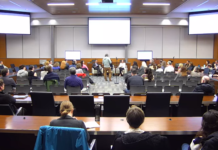<em>F</em><em>ight Club. Scarface. Donnie Darko.</em> There are plenty of movies that, while maybe not having initial success, gain a cult status that makes them into classics after their initial release. The <em>Zelda</em> series is no stranger to this.</p>
Majora’s Mask has always had a black sheep status in the Zelda series. While Wind Waker got flack for its more cartoony form, Majora’s Mask’s more unpopular aspects are less tangible.
It is a title that, by developer admission, was formed from reused assets from the previous Ocarina of Time, and had a far shorter development time. The darker tone may have turned people off, as did the three-day time limit on gameplay. But it’s the subtle elements around the game that drew people in.
The story is simple, even for Zelda. A mischievous Skull Kid gets his hands on the titular mask, and is about to crash the moon into the land of Termina. Rest assured, our hero, Link, is on the case, but with a three-day countdown to remove the threat he must keep restarting time and complete four dungeons that may help in stopping the incoming cataclysm.
It isn’t the hero’s journey that makes this game interesting — it’s the people around him. Majora’s darkness isn’t one that manifests as dark miasma or hordes of Orcs, though the intense, staring eyes of Majora’s mask always creeped me out.
The core area of Clock Town, on the surface, is not a gloomy place at all. There’s cheerful music, carpenters work on things for the upcoming festival, the postman continues his route unhindered, and businesses are perfectly functional.
But as the infamously creepy face of the moon looms closer, the undercurrent of impending doom peeks from the corners of the game.
The darkest part of Majora’s Mask isn’t the panic of a doomed town. It’s a town in denial, irrevocably continuing their daily mundane tasks for the sake of some semblance of control, that insane societal desire to keep a sense of sameness even as the world falls apart. And at the bitter end, the reactions are different, but all desperate.
The normally boastful swordmaster can be found in the back of his house, cowering for his life. The head carpenter defiantly mocks the moon, even as his own sons have run away and the streets are deserted. At the Romani Ranch, Cremia, knowing her inability to escape the moon’s fall, just asks her unaware little sister to sleep in her bed that night.
This manifests in gameplay as well. No matter what you do, how much you help people, the moon will fall. You can only continue to restart time, ensuring Termina’s continued survival, but resetting the help you’ve given people. That reunion of two lovers? That rescue of the ranch from aliens? Back to square one. Only your memories and what little items and boons survived the time jump remain. And you only delay the inevitable.
There’s been much made of aspects of the game, with its different areas thought to be representing the stages of grief: denial, anger, bargaining, depression, and acceptance.
An angry Deku King blaming a monkey for his daughter’s kidnapping. A Goron hero’s ghost pleading with you to bring him back to life. A depressed Zora songstress crying for the loss of her eggs. A land of living dead, with few new living characters to help or new transformations to take. Just you and death around you.
There are even theories of our hero in the story actually being dead, with the land of Termina a manifestation of his dealings with his own mortality.
It may just be a fan theory, but it’s interesting as hell, and something many people latch on to.
Gameplay-wise, Majora’s Mask is certainly not perfect. But that’s not what people remember. It’s the ever- looming moon, and the people living under its inevitable fall.
It might just be thinking too much about a video game released in 2000. But if you look into the concealed darkness of Majora’s Mask, you may just see something stare back.































